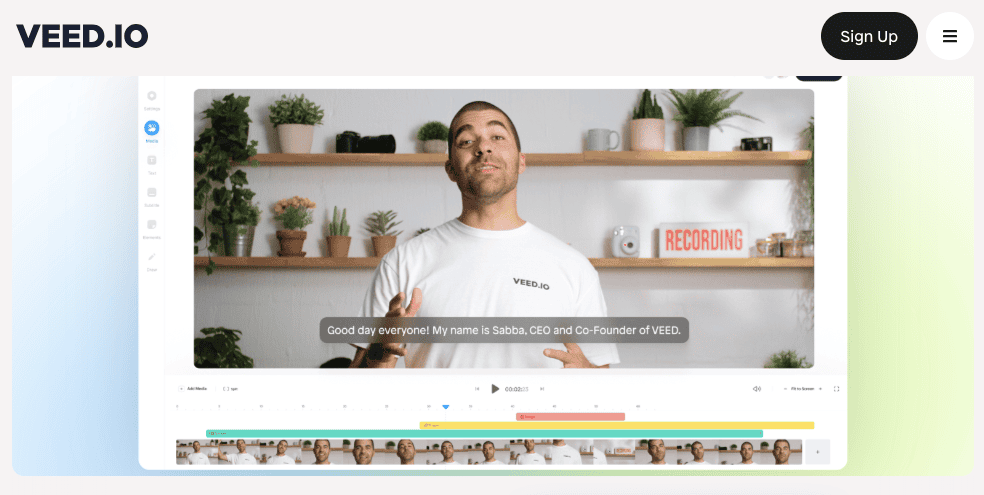Veed AI
Overview

We use the most powerful video editor tools to help you expand your brand, channel or video blog.
This article is from Tom Hunt and tells the story of how Sabba and Tim created VEED, an online video editing software that allows users to create video and audio playlists and share them on social media. Here's how Sabba and Tim developed this software and realized $25,000 a month and nearly $1 million a year in revenue?
That's how VEED came to be! It's an amazing story!
Sabba and Tim met at a programming marathon in 2014, Tim was studying computer science at Kings College London and Sabba was working as a creative director at a creative agency. They also tried their hand at a number of different projects before developing VEED.
Their first project was an agency app that brought in a few thousand dollars, but they eventually sold it for $5,000.
In 2017, Tim returned to college to finish his final year while Sabba discovered some new trends as a freelance designer. At the time, he was working for a marketing agency, getting paid £400 for adding text to Google videos.
Coincidentally, Tim's final year research project was to build an AI automated video editing tool that could convert a written article into a video, called "VEED". Sabba, on the other hand, used Giphy's online video editor to create GIFs.
Their ideas collided and a new project was born! Sabba designed it, Tim wrote the code, and they secured a place in a 12-month incubator launch at King's College London.
No funding for your business? They won £40,000 by entering a startup competition!
At the time, they each had around £6,000 in the bank, which would have been needed to sustain them for over a year if they hadn't accepted external funding. That means they only had £500 a month to live on, which is totally inadequate in London. Therefore, they decided to get funding either through equity investment or through a startup competition.
However, both paths preferred a more robust and valuable product rather than just an automated video editor. So, they eventually turned to an AI video creation tool for eCom product videos, the ones you see on ASOS product pages.
Sabba then proceeded to fly around the world and then win various startup competitions.
In the space of 12 months, Sabba won £40,000 in prizes for entering startup competitions. It sounded great, but the biggest problem was that investors and competition judges loved it, but customers didn't.
In August 2018, they decided to give up on the fundraising idea, stopped offering an AI video production service for eCom stores, and removed some of the functionality of their online video editing tool before releasing it on Product Hunt. Since then, VEED as you know it today was officially born. It took them almost 4 years to decide to focus on this product called VEED, which was a "roller coaster" of an entrepreneurial process.
However, the story has just begun at .....
The next part of the story is their secret to user growth:
Growth Tip #1: Compulsive Customer Interviews Sabba spends 5 hours a day talking to customers.
Method 1: Phone interviews. He calls customers directly to find out what they are thinking, to keep up with changing needs, and to get to the features they want before his competitors do. He understands that if he doesn't know what his customers think, he can't create a product that people will love.
Way 2: Send an email. Every user who signs up for VEED receives an email that reads, "You're hot, you're funny ...... You receive an email from the CEO asking for help with a positive pro-product issue. Obviously you're willing to take him up on his offer."
I expected this email to result in a higher conversion rate for us, and clearly, it worked.
Currently, Sabba is getting 15-20 inbound calls a week, and he's basically at home somewhere in Nigeria talking to customers every minute of every day.
In addition to making connections and reducing churn in these ways, Sabba is incorporating valuable feedback into product planning, and Tim and the rest of the development team are improving the product every day.
First, we're telling users through a number of influencers that they're going to get $80,000 worth of value out of their $20 per month subscription.
Second, I have a clear CTA (call to action) that serves as a copywriting pitch.
Sabba can also answer customer feedback verbatim and then add this copy to the site to increase conversions:
Add a 15-minute boarding call to the first email for all new subscribers
Over the past three months, I've talked to a lot of founders of fledgling SaaS companies about growing their business, and I've found that one of the biggest challenges they face is how to create valuable, engaging content.
Growth Tip #2: Produce Socially Relevant Content
The vast majority of our content output comes from Sabba, which, in addition to the VEED blog, regularly uploads relevant and timely content to the VEED Grow blog to help content creators rise in popularity on the web:
Timely content performs better on social networks because people like to "keep up with the trends", and this early infusion of social traffic helps rank posts on Google, which over time becomes an advantage in attracting attention:
Recently, Sabba has phased out content creation and handed over this socially relevant content framework to team members or freelancers to continue to execute:
This is both a content marketing lesson and an outsourcing experiment: in order to effectively train someone to achieve the end result, you must first execute the process and get the desired end result yourself.
You can then document the process, hand it off and train another person to perform it. If Sabba had just found some freelance writers and asked them to "get attention for VEED," he would have either failed or had to spend more money to find a professional organization to execute the process.
Growth Tip #3: Focus on Search Engine Optimization Efforts
Through keyword ranking optimization, VEED's organic traffic grew from zero to 9,000:
10,000 visits per month in two years:
How do you do this on a limited budget and in a limited amount of time? We use a strategy of "segmentation and close association":
Segmentation - you do keywords that have traffic, but have not yet been done by everyone to do bad words
Closely related - you do keywords that naturally transition into free trials (or demos) of your product.
How does VEED use this strategy?
With SEMRush, they learned what keywords their competitors were ranking for and then prepared to outrank them.
Let's take a look at the keyword "video effects":
First, he created a simple, interactive landing page with video examples and "social recognition" style endorsements: https://www.vee.io/video -effects
The key word here is interactive.
Google is smart enough to know when people are actually interacting with your content (clicking, uploading, scrolling) and prioritize a page to generate more engagement.
That's why VEED allows page visitors to upload videos and then utilize this feature:
The page is clean, fast-loading, scrollable, and has multiple CTAs (Calls to Actions), including a scrolling "Sign Up" button.
Now that the page is live, it's time to drive some traffic.
Early on, Google also likes to see relatively new pages generate some social and referral traffic. So the VEED team released these landing pages just like they would release a new product on Product Hunt ......
Notice the strategic placement of keywords everywhere:
An example of a video is the Halloween theme that was released on October 31st (it's something small...)
This video got 372 likes, more than most products get at launch, let alone a new feature.
No doubt this post-launch exposure will generate 692 backlinks, several of which will point to the login page:
This post went live on October 31, 2019, and by December 5, they were in fifth place:
By January 8, 2020, it ranked #2:
To summarize:
1. choose a niche keyword for which competitors are ranking high 2. build an interactive landing page around that keyword 3. shortly after launch, drive social and referral traffic to that landing page 4. it would be great to get some backlinks along the way 5. ranking
The VEED team repeats this strategy with every new feature, and here's a history of Sabba's "manufactured" product launches:
Knowledge point: What features of your product are currently being searched for, and do you have specific, interactive landing pages for those features?
Growth Tip #4: "Out of the Box" Traffic Sources This is what I received from Sabba last November:
This is what I received from Sabba last November. He accidentally discovered an untapped traffic source and started paying them $75 per day and now gets 881 visits per hour.
Let's take a closer look:
He put a banner ad on this site:
If the traffic changes, it is estimated that the number of users per month will increase from 50,000 to 600,000, a 6-fold increase.
It could be a game changer for growth...
At the time, traffic from the banner ads was first sent to the Create Account page and then moved to the editor, which didn't convert very well.
In response, Sabba and the team tweaked and improved by directing traffic to the video editor instead of asking users to sign up for an account first - to show the value of the product before inviting signups.
Despite these changes, the traffic still didn't convert very well:
While there were 13,525 visitors but 0 paying users
Although it didn't lead to conversions, you need to try it once for such a traffic source.
It's important to note that this type of traffic source needs to be kept secret and once you reveal it to others, competitors will flock to it.
So, if you find a traffic source like this, keep it on the down low~
Growth Tip #5: User-Led Growth
Viral fission growth resulting from users actively recommending your product is what we call user-led growth. Like many other startup SaaS products, VEED offers a free plan for users who pass on information:
Free users cost VEED cash in the form of data storage and bandwidth costs, although they still offer free plans. They do this because free users can only download videos with VEED's watermark, which gives them brand exposure to the viewers who watch those videos, which will inevitably increase conversions to paid users.
At the end of December 2018, VEED's monthly live users grew from 10,000 to 30,000, and at that time, the product was still free, so they needed to re-fund to maintain their cost of living. However, they were rejected by capital for not charging users.
In desperation, they changed their strategy. That weekend, Tim and Sabba decided to add a watermark to all free user-made videos, and users would have to pay $5 a month to remove the watermark. By Monday, they pushed out the update in real time and immediately added 20 new paying subscribers.
Although VEED has taken them more than five years to develop, they are now successful, with VEED generating $25,000 in regular monthly revenue and nearly $1 million in annual revenue. They own 100% of the company, which sustains them. What matters most in this SaaS growth story is their patience and persistence.
Note: Originally compiled from saasmarketer with the original title Bootstrapping To $25k MRR - The VEED Story














